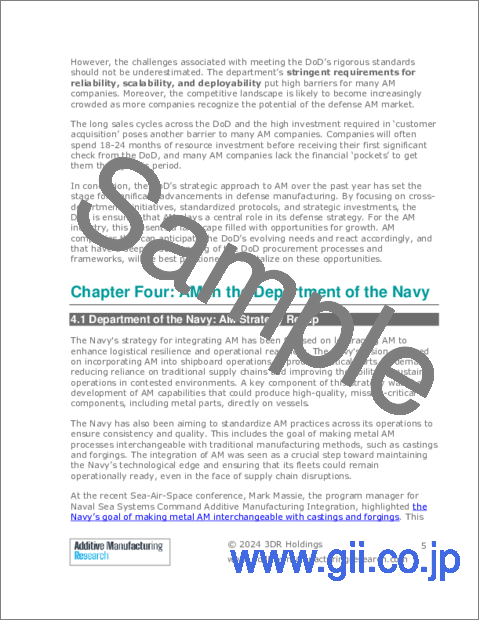|
|
市場調査レポート
商品コード
1619717
軍事・防衛部門における付加製造 (AM):2024年Additive Manufacturing in Military and Defense 2024 |
||||||
|
|||||||
| 軍事・防衛部門における付加製造 (AM):2024年 |
|
出版日: 2024年12月30日
発行: Additive Manufacturing Research
ページ情報: 英文
納期: 即納可能
|
- 全表示
- 概要
- 目次
AM Researchによると、2024年の米国国防総省 (DoD) による3Dプリンティング (3DP)/ 付加製造 (AM) への直接投資市場は8億米ドルに達し、前年比166%の成長を示すと推計されています。力強い成長は2020年代の終わりまで続き、2030年には軍事・防衛AMの市場規模は26億米ドルを超えると予想されています。
当レポートは、軍事・防衛部門における3Dプリンティング (3DP)/ 付加製造 (AM) の機会を分析・予測したもので、米国の軍事・防衛イニシアチブに焦点を当てています。米国海軍、空軍および宇宙軍、陸軍の専門家および直接のインタビューに基づく分析が提供され、軍および防衛部門への販売を目指すAMベンダーへの提言が示されています。
当レポートでは、米国DoDの予算を考慮し、粉末床融合法、指向性エネルギー堆積法、金属バインダージェッティング法、バウンドメタルデポジション法など、主要な3Dプリンティングのすべてのタイプについて、Excelベースで市場規模の推計・予測を行っています。当レポートは、ポリマーおよび金属AD市場の両方について、ハードウェア、材料、印刷サービスから得られる収益を考察しています。
掲載企業・組織:米国DoD、AM Forward (ASTRO America) 、America Makes、BlueForge Alliance、3YourMind、Hylion、Ursa Major、Defense Innovation Unit、Concurrent Technologies、Lincoln Electric、Fairbanks Morse Defense、Pratt &Whitney、ADDMAN Group、3D Systems、SPEE3D、Essentium、MELD Manufacturing、Authentise、Fortius Metals、AFWERX、RapidFlight、Rocket Lab、Airbus、Boeing、ExOne、Lithoz、Continuous Composites、Phillips Corporation、Eaton Corporationなど
目次
第1章 米国は産業基盤を再構築しており、AMが利益を得る可能性がある
- 産業基盤の再構築は米国政府にとって戦略的優先事項である
- 米国政府は経済不確実性の中でAM産業を強化
- AMは米国政府の戦略実行において重要な役割を果たす
- AMと連邦政府の共生関係
- 当レポートについて:DoDにおけるAMの詳細な分析
第2章 DoDにおけるAM導入の進化の概要
- DoDにおけるAM導入の進化
- DoDのAM早期導入から学んだ教訓
第3章 DoDのAM導入における戦略的展開
- 戦略的方向性と政策枠組み
- 予算配分と戦略的投資
- 米国の防衛部門 (DoDおよび防衛関連請負業者) のAM支出
- 米国防衛部門におけるAM市場機会の推定
- AMサブプロセスと材料の特定の機会領域の定量化
- サービスとハードウェアのさまざまな機会を推進するサービス部門
- AM業界への影響
第4章 海軍省におけるAM
- 海軍省:AM戦略の要約
- 海軍のAM重点分野:船上展開
- 海軍のAM重点分野:潜水艦生産におけるAMでタイムラインを加速
- 海軍のAM重点分野:知識を広めるためのトレーニングと研究センター
- 海軍のAM重点分野:海兵隊の遠征AM
- 海軍におけるAM:さらなる発展
第5章 空軍省におけるAM
- 空軍省:AM戦略の要約
- 空軍のAM重点分野:迅速な維持とロジスティクスのためのAM
- 空軍のAM重点分野:飛行に不可欠な部品のAM
- 空軍のAM重点分野:ドローンはAMの「ホットな」アプリケーション
- 空軍のAM重点分野:宇宙用途向けAM
- 空軍におけるAM:さらなる開発
第6章:陸軍省におけるAM
- 陸軍省:AM戦略の要約
- 陸軍のAM重点分野:MROと艦隊近代化のためのAM
- 陸軍のAM重点分野:大判印刷
- 陸軍のAM重点分野:建設3Dプリント
- 陸軍におけるAM:さらなる発展
第7章 米国DoDへの販売を希望するAMベンダーへの推奨事項
- DoDへの販売- 複雑だがやりがいのある道
- 直接参入と提携アプローチ
- DoDの中小企業リソースの活用
- AMベンダーが契約の成功率を高めるための手順
- 長期的な成功に向けたポジショニング
付録:DoDの調達の枠組みと役立つリンク
- A-1.DoD調達の枠組みの概要
- A-2.便利なリンク
- AD研究について
- アナリストについて
AM Research sees an $800M market for direct US DoD spend on 3DP/AM 2024, marking growth of 166% year over year. Strong growth is expected to maintain through the end of the decade, to a market for military/defense AM exceeding $2.6B in 2030.
This new report analyses and forecasts opportunities for 3D printing in the military and defense sectors that are larger and faster growing than described in the original (2023) report. Insights into the transformative role of AM within this critical sector are provided throughout the comprehensive market study, which sheds light on the rapid evolution and current and potential impact of AM technologies on the defense and military landscape.
The study's findings hold significant implications for defense contractors, technology providers, investors and policymakers, indicating the need for proactive measures to harness the full potential of AM in addressing the ever-evolving national security landscape. Geopolitics have only gotten more tenuous in the thirteen months since the 2023 version of this report was published. Escalating and evolving global tension and security challenges position the 3DP/AM industry as crucial for defense and military entities to conceptualize, develop, and deploy critical assets and equipment.
"Additive Manufacturing in Military and Defense 2024" focuses on the United States' military and defense initiatives to incorporate and leverage 3D printing into its operations. Analysis is provided based on expert and first-person interviews within the US Navy, US Air Force and Space Force, and the US Army, and offers recommendations for additive manufacturing vendors seeking to sell into the military and defense sector.
The report considers the United States Department of Defense budget and features an Excel-based market sizing and forecasting for all leading types of 3D printing, including Powder Bed Fusion, Directed Energy Deposition, Metal Binder Jetting and Bound Metal Deposition. The report considers revenues derived from hardware, materials and printing services for both the polymer and metal additive manufacturing markets.
Companies and organizations mentioned or profiled include but are not limited to: Department of Defense, AM Forward (ASTRO America), America Makes, BlueForge Alliance, 3YourMind, Hyliion, Ursa Major, Defense Innovation Unit, Concurrent Technologies, Lincoln Electric, Fairbanks Morse Defense, Pratt & Whitney, ADDMAN Group, 3D Systems, SPEE3D, Essentium, MELD Manufacturing, Authentise, Fortius Metals, AFWERX, RapidFlight, Rocket Lab, Airbus, Boeing, ExOne, Lithoz, Continuous Composites, Phillips Corporation, Eaton Corporation, and more.
AM Research's reports are intended as key strategic inputs for all senior executives planning 3D printing product/market strategies and for investors who are looking to take equity positions in 3D printing firms.
AM Research also offers customized consulting, research, and due diligence analysis.
Table of Contents
Chapter One: The USA is Rebuilding Its Industrial Base and Additive Manufacturing Stands to Gain
- 1.1. Re-Building the Industrial Base is a Strategic Priority for the U.S. Government
- 1.2. The U.S. Government is Bolstering the AM Industry Amidst Economic Uncertainty
- 1.3. AM Plays an Important Role in the Execution of the U.S. Government's Strategy
- 1.4. Symbiotic Relationship Between AM and the Federal Government
- 1.5. About this Report: Deep Dive into AM in the DoD
Chapter Two: Recap of The Evolution of AM Adoption within the DoD
- 2.1. The Evolution of AM Adoption within the DoD
- 2.2. Lessons Learned from the DoD's Early Adoption of AM
Chapter Three: Strategic Developments in DoD AM Adoption
- 3.1. Strategic Directions and Policy Frameworks
- 3.2. Budget Allocations and Strategic Investments
- 3.3. Defense Sector (DoD and Defense Contractors) Spend on AM in the U.S.
- 3.3.1. Estimating AM Market Opportunities in the U.S. Defense Sector
- 3.3.2. Quantifying Specific Areas of Opportunity for AM Sub-Processes and Materials
- 3.3.3. Branches of Service Driving Various Opportunities in Services and Hardware
- 3.4. Implications for the AM Industry
Chapter Four: AM in the Department of the Navy
- 4.1. Department of the Navy: AM Strategy Recap
- 4.2. Navy's AM Focus Areas: Onboard Deployments
- 4.3. Navy's AM Focus Areas: AM in Submarines Production to Accelerate Timelines
- 4.4. Navy's AM Focus Areas: Training & Research Centers to Disseminate Knowledge
- 4.5. Navy's AM Focus Areas: Expeditionary AM in the Marine Corps
- 4.6. AM in the Navy: Additional Developments
Chapter Five: AM in the Department of the Air Force
- 5.1. Department of the Air Force: AM Strategy Recap
- 5.2. Air Force's AM Focus Areas: AM for Rapid Sustainment and Logistics
- 5.3. Air Force's AM Focus Areas: AM for Flight-Critical Parts
- 5.4. Air Force's AM Focus Areas: Drones are a "Hot" Application for AM
- 5.5. Air Force's AM Focus Areas: AM for Space Applications
- 5.6. AM in the Air Force: Additional Developments
Chapter Six: AM in the Department of the Army
- 6.1. Department of the Army: AM Strategy Recap
- 6.2. Army's AM Focus Areas: AM for MRO and Fleet Modernization
- 6.3. Army's AM Focus Areas: Large-Format Printing
- 6.4. Army's AM Focus Areas: Construction 3D Printing
- 6.5. AM in the Army: Additional Developments
Chapter Seven: Recommendations for AM Vendors Seeking to Sell into the U.S. DoD
- 7.1. Selling to the DoD - A Complex yet Rewarding Path
- 7.2. Direct Entry vs. Partnering Approaches
- 7.3. Leveraging DoD Small Business Resources
- 7.4. Steps for AM Vendors to Enhance Contract Success
- 7.5. Positioning for Long-Term Success
Appendix: DoD Procurement Frameworks and Useful Links
- A-1. DoD Procurement Frameworks Overview
- A-2. Useful Links
- About Additive Manufacturing Research
- About the Analyst
List of Exhibits
- Exhibit 1-1: U.S. Construction Spending 2018-2023
- Exhibit 1-2: USA Small Business Administration's Investment Matching Program
- Exhibit 3-1: AM Defense Spending in U.S.
- Exhibit 4-1: FMD's 3D-Printed Valve Assembly
- Exhibit 4-2: Additively Manufactured Small Motor Cases and Components For Tactical Missile Applications
- Exhibit 5-1: Illustration of the First Metal 3D Printer to Board the International Space Station
- Exhibit A-1: DoD Procurement Frameworks High-Level Overview
- Exhibit A-2: SBIR Phase Overview
- Exhibit A-3: SBIR Timeline
- Exhibit A-4: Web Resources and Links





